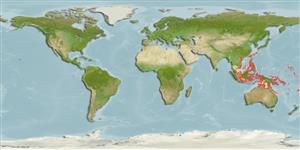Common names from other countries
>
Ovalentaria/misc (Various families in series Ovalentaria) >
Pseudochromidae (Dottybacks) > Pseudochrominae
Etymology: Cypho: Greek, kypho = curved (Ref. 45335); zaps: Name from Greek zaps, meaning storm for the weather conditions when collections were made; noun in apposition..
More on author: Gill.
Environment: milieu / climate zone / depth range / distribution range
Ekologi
marina revassocierade; djupintervall 5 - 35 m (Ref. 90102). Tropical
Utbredning
Länder | FAO områden | Ekosystem | Förekomster | Point map | Utplanteringar | Faunafri
Western Pacific: from the Ryukyu Is., Taiwan, the Philippines and Indonesia.
Size / Vikt / Age
Maturity: Lm ? range ? - ? cm
Max length : 5.1 cm SL hane/ej könsbestämd; (Ref. 81967)
Short description
Bestämningsnycklar | Morfologi | Morfometri
Taggstrålar i ryggfenan (totalt) : 3; Mjukstrålar i ryggfenan (totalt) : 22 - 23; Taggstrålar i analfenan: 3; Mjukstrålar i analfenan: 14.
Collected on reef slopes and reef surge channels (Ref. 81967). Solitary or in pairs (Ref 90102).
Life cycle and mating behavior
Maturities | Reproduktion | Spawnings | Egg(s) | Fecundities | Larver
Gill, A.C., 2004. Revision of the Indo-Pacific dottyback fish subfamily Pseudochrominae (Perciformes: Pseudochromidae). Smith. Monogr. (1):1-213. (Ref. 81967)
IUCN Red List Status (Ref. 130435)
CITES (Ref. 128078)
Not Evaluated
Threat to humans
Harmless
Human uses
Verktyg
Special reports
Download XML
Internet-källor
Estimates based on models
Preferred temperature (Ref.
115969): 26.5 - 29, mean 28.1 (based on 280 cells).
Phylogenetic diversity index (Ref.
82804): PD
50 = 0.7500 [Uniqueness, from 0.5 = low to 2.0 = high].
Bayesian length-weight: a=0.00490 (0.00187 - 0.01281), b=3.11 (2.88 - 3.34), in cm Total Length, based on LWR estimates for this (Sub)family-body shape (Ref.
93245).
Trofisk nivå (Ref.
69278): 3.4 ±0.5 se; based on size and trophs of closest relatives
Fishing Vulnerability (Ref.
59153): Low vulnerability (10 of 100).
